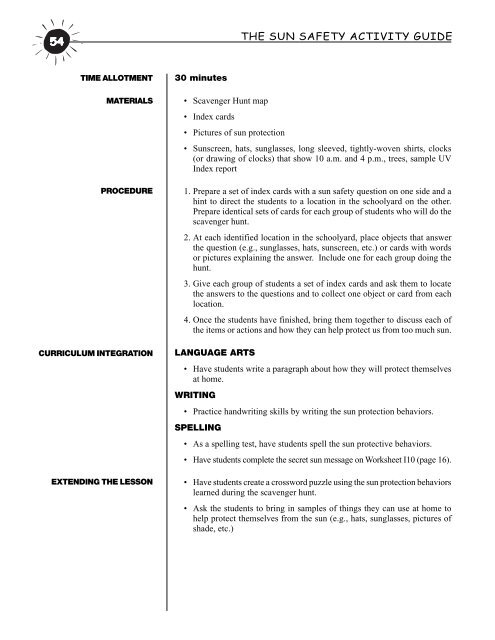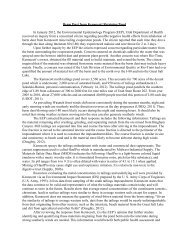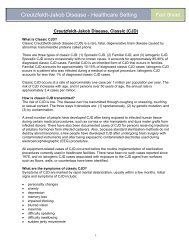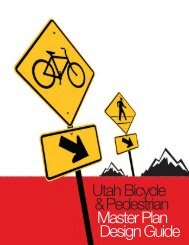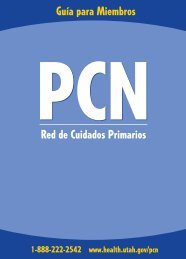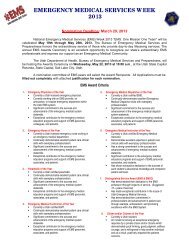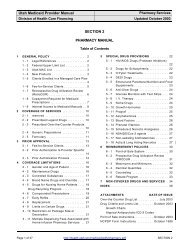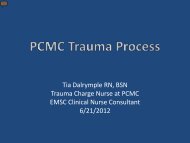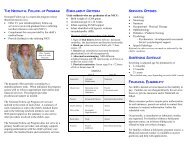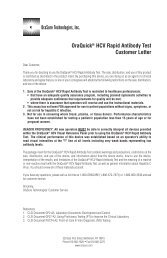THE SUN SAFETY ACTIVITY GUIDE - Utah Department of Health
THE SUN SAFETY ACTIVITY GUIDE - Utah Department of Health
THE SUN SAFETY ACTIVITY GUIDE - Utah Department of Health
You also want an ePaper? Increase the reach of your titles
YUMPU automatically turns print PDFs into web optimized ePapers that Google loves.
54<br />
<strong>THE</strong> <strong>SUN</strong> <strong>SAFETY</strong> <strong>ACTIVITY</strong> <strong>GUIDE</strong><br />
TIME ALLOTMENT<br />
MATERIALS<br />
PROCEDURE<br />
CURRICULUM INTEGRATION<br />
EXTENDING <strong>THE</strong> LESSON<br />
30 minutes<br />
• Scavenger Hunt map<br />
• Index cards<br />
• Pictures <strong>of</strong> sun protection<br />
• Sunscreen, hats, sunglasses, long sleeved, tightly-woven shirts, clocks<br />
(or drawing <strong>of</strong> clocks) that show 10 a.m. and 4 p.m., trees, sample UV<br />
Index report<br />
1. Prepare a set <strong>of</strong> index cards with a sun safety question on one side and a<br />
hint to direct the students to a location in the schoolyard on the other.<br />
Prepare identical sets <strong>of</strong> cards for each group <strong>of</strong> students who will do the<br />
scavenger hunt.<br />
2. At each identified location in the schoolyard, place objects that answer<br />
the question (e.g., sunglasses, hats, sunscreen, etc.) or cards with words<br />
or pictures explaining the answer. Include one for each group doing the<br />
hunt.<br />
3. Give each group <strong>of</strong> students a set <strong>of</strong> index cards and ask them to locate<br />
the answers to the questions and to collect one object or card from each<br />
location.<br />
4. Once the students have finished, bring them together to discuss each <strong>of</strong><br />
the items or actions and how they can help protect us from too much sun.<br />
LANGUAGE ARTS<br />
• Have students write a paragraph about how they will protect themselves<br />
at home.<br />
WRITING<br />
• Practice handwriting skills by writing the sun protection behaviors.<br />
SPELLING<br />
• As a spelling test, have students spell the sun protective behaviors.<br />
• Have students complete the secret sun message on Worksheet I10 (page 16).<br />
• Have students create a crossword puzzle using the sun protection behaviors<br />
learned during the scavenger hunt.<br />
• Ask the students to bring in samples <strong>of</strong> things they can use at home to<br />
help protect themselves from the sun (e.g., hats, sunglasses, pictures <strong>of</strong><br />
shade, etc.)
<strong>THE</strong> <strong>SUN</strong> <strong>SAFETY</strong> <strong>ACTIVITY</strong> <strong>GUIDE</strong><br />
55<br />
Sun Protection Presentation<br />
Prevention–Students will demonstrate what they have learned about the<br />
damage ultraviolet rays can have on the skin and ways to practice sun protection.<br />
Intermediate (I11)<br />
OBJECTIVE<br />
• Habits to live by include:<br />
» Limit time in the sun during 10 a.m. and 4 p.m.<br />
» Be in the shade whenever you can<br />
» Wear your hat and sunglasses when outside<br />
» Wear sunscreen<br />
» Wear a shirt with long sleeves when you can<br />
» Use the daily UV Index<br />
Explain to the students:<br />
• Begin the project by initiating a discussion with students on their<br />
experiences with the sun, such as sunburns, suntans, use <strong>of</strong> sun protection,<br />
etc.<br />
• Provide pictures <strong>of</strong> people participating in various outdoor activities, ask<br />
students for observations and predictions <strong>of</strong> long and short term effects<br />
<strong>of</strong> the sun on these people. Refer students to their knowledge <strong>of</strong> solar<br />
energy.<br />
• While the sun has many positive effects on us, too much sun can lead to<br />
sunburn, damage to the eyes, skin cancers, and premature wrinkling. Sun<br />
protection should be a daily habit, just like brushing your teeth.<br />
30 minutes<br />
1. Break the students into groups.<br />
2. Have the different groups develop a 5-minute presentation, play, or<br />
television advertisement to educate either parents, other students, friends,<br />
school <strong>of</strong>ficials, or community members about sun protection.<br />
3. Assign one audience to each group.<br />
4. Some <strong>of</strong> the questions for the students to consider addressing might be:<br />
» At what age might sun damage begin?<br />
» Why should their audience be concerned?<br />
» What are the sun protection habits?<br />
5. Have the groups do their presentation for the rest <strong>of</strong> the class (or other<br />
classes or school <strong>of</strong>ficials).<br />
LEARNING OBJECTIVES<br />
DISCUSSION<br />
TIME ALLOTMENT<br />
PROCEDURE
56<br />
<strong>THE</strong> <strong>SUN</strong> <strong>SAFETY</strong> <strong>ACTIVITY</strong> <strong>GUIDE</strong><br />
CURRICULUM INTEGRATION<br />
EXTENDING <strong>THE</strong> LESSON<br />
LANGUAGE ARTS<br />
• Have students write a paper about how they will get their families to<br />
adopt sun protection habits.<br />
WRITING/SPELLING<br />
• Find as many three or more lettered words as possible out <strong>of</strong> the letters in<br />
<strong>SUN</strong> PROTECTION (Idea adapted from The Skin Cancer Foundation’s<br />
Sunny States <strong>of</strong> America)<br />
• Create a crossword puzzle on sun protection habits. For assistance, go to<br />
Web site http://www.puzzlemaker.com. Or use Worksheet I11 on page 76.<br />
• Have students make their presentations at the next PTA meeting, school<br />
board meeting, or school assembly.<br />
• Have a dermatologist talk with the class about sun protection.
<strong>THE</strong> <strong>SUN</strong> <strong>SAFETY</strong> <strong>ACTIVITY</strong> <strong>GUIDE</strong><br />
57<br />
Sun Safe Behavior<br />
Prevention–Students will learn about the dangers <strong>of</strong> overexposure to the<br />
sun and explain how they can make their home, school, and community sun<br />
safe.<br />
• Ask the Students:<br />
» What are the dangers <strong>of</strong> too much sun?<br />
» How does the media influence people to think that a suntan is beautiful?<br />
» How do families and communities benefit from sun safe behaviors?<br />
Intermediate (I12)<br />
OBJECTIVE<br />
LEARNING OBJECTIVES<br />
Explain to the students:<br />
30 minutes<br />
• Chart paper<br />
• Notebook paper, pencils<br />
• Ads showing sun safety, tanning, skin cancer<br />
1. Divide the students into three work groups. Have each group brainstorm to<br />
generate a list <strong>of</strong> questions they would want answers to determine the extent<br />
to which sun safety products are evident their homes, community, and school.<br />
Assign one <strong>of</strong> the three topics to each group. Give students a time limit, and<br />
have them select a recorder and a reporter.<br />
2. Have each group report to the class their list <strong>of</strong> questions for home, school,<br />
and community. Use the chart paper or the board to list them. Let students<br />
from other groups suggest questions to add or delete. Select four to six<br />
questions for each category.<br />
3. Select the best four questions from each category (home, school, community),<br />
and have each student write and number the questions from each topic.<br />
4. Students should use three pieces <strong>of</strong> notebook paper (one for each category)<br />
and leave spaces between each question to write a response. Or copy and<br />
distribute the Sun Safety Survey (see Workesheet I12 on page 78). Have<br />
students complete the survey questions for homework.<br />
• Have students use the reports from their surveys and look at the data gathered<br />
by the whole class. Select three good students to represent each category<br />
(home, school, and community). Have them collect all responses to their<br />
assigned categories. Have students answer the following questions:<br />
1. On a scale 1-10, with 10 being the most sun safe, how would you rate our:<br />
» School » Home » Community<br />
2. What rules and laws are evident in our:<br />
» School » Home » Community<br />
3. What do you think can and should be done to increase sun safety in the:<br />
» School » Home » Community<br />
TIME ALLOTMENT<br />
MATERIALS<br />
PROCEDURE<br />
EXTENDING <strong>THE</strong> LESSON
58<br />
<strong>THE</strong> <strong>SUN</strong> <strong>SAFETY</strong> <strong>ACTIVITY</strong> <strong>GUIDE</strong>
<strong>THE</strong> <strong>SUN</strong> <strong>SAFETY</strong> <strong>ACTIVITY</strong> <strong>GUIDE</strong><br />
59<br />
IV. Worksheets<br />
Worksheet P2<br />
Write the object you found outside, where you found it... Sun?<br />
Shade? and what it felt like.<br />
OBJECT LOCATION FEELING<br />
(where was it)<br />
(hot, cold, warm)<br />
___________________ _________________ _________________<br />
___________________ _________________ _________________<br />
___________________ _________________ _________________<br />
___________________ _________________ _________________<br />
___________________ _________________ _________________<br />
___________________ _________________ _________________<br />
___________________ _________________ _________________<br />
___________________ _________________ _________________<br />
___________________ _________________ _________________<br />
___________________ _________________ _________________<br />
___________________ _________________ _________________<br />
___________________ _________________ _________________
60<br />
<strong>THE</strong> <strong>SUN</strong> <strong>SAFETY</strong> <strong>ACTIVITY</strong> <strong>GUIDE</strong><br />
Worksheet P4<br />
Take a look at your skin.<br />
Once you have filled out<br />
your skin description,<br />
write your neighbors.<br />
Skin Color<br />
(use crayon to<br />
ME<br />
MY NEIGHBOR<br />
show skin color)<br />
How are you different?<br />
The Same?<br />
Rough/Smooth<br />
Hair on skin<br />
(yes/no)<br />
Scratches<br />
(yes/no)<br />
Scars<br />
(yes/no)<br />
Freckles<br />
(yes/no)<br />
How many on<br />
your arm<br />
Hair Color<br />
(use crayon to<br />
show hair color)<br />
Eye Color<br />
(use crayon to<br />
show eye color)<br />
What else do you<br />
notice about your skin?
<strong>THE</strong> <strong>SUN</strong> <strong>SAFETY</strong> <strong>ACTIVITY</strong> <strong>GUIDE</strong><br />
61<br />
Worksheet P5<br />
Which picture is different?<br />
Circle the picture that is different. What sun safety habit are they showing?<br />
Source: Sunny States <strong>of</strong> America, The Skin Cancer Foundation<br />
Copyright © Sun Pharmaceuticals
62<br />
<strong>THE</strong> <strong>SUN</strong> <strong>SAFETY</strong> <strong>ACTIVITY</strong> <strong>GUIDE</strong><br />
Worksheet P6<br />
How to make a sun safety hat...<br />
1. Fold a large piece <strong>of</strong> paper into fours. Paper should be large enough to<br />
make a hat that extends one inch over the face, ears, and neck.<br />
2. Draw an arc from one edge <strong>of</strong> the page to the other edge on the paper<br />
3. Cut along the line and open up your circle.<br />
4. Decorate your circle.<br />
5. Cut a line from the edge <strong>of</strong> the circle<br />
6. Overlap the cut edges to form a cone.<br />
7. Stapleor glue the cone together.<br />
Idea adapted in part from Australia’s SunSmart Fun for Everyone
<strong>THE</strong> <strong>SUN</strong> <strong>SAFETY</strong> <strong>ACTIVITY</strong> <strong>GUIDE</strong><br />
63<br />
Worksheet P7<br />
Take a look at these pictures. What protects each object from the sun?<br />
Source: California <strong>Department</strong> <strong>of</strong> <strong>Health</strong> Services, California<br />
Early Childhood Protection Curriculum, 1998.
64<br />
<strong>THE</strong> <strong>SUN</strong> <strong>SAFETY</strong> <strong>ACTIVITY</strong> <strong>GUIDE</strong><br />
Worksheet P9<br />
Make Some Cool Shades!<br />
Source: California <strong>Department</strong> <strong>of</strong> <strong>Health</strong> Services, California<br />
Early Childhood Protection Curriculum, 1998
<strong>THE</strong> <strong>SUN</strong> <strong>SAFETY</strong> <strong>ACTIVITY</strong> <strong>GUIDE</strong><br />
65<br />
Worksheet P10<br />
Sun Word Find<br />
Circle the sun words below. The words can be up,<br />
down, left, right, diagonal, and backwards.<br />
Source: Sunny States <strong>of</strong> America, The Skin Cancer Foundation<br />
Copyright © Sun Pharmaceuticals
66<br />
<strong>THE</strong> <strong>SUN</strong> <strong>SAFETY</strong> <strong>ACTIVITY</strong> <strong>GUIDE</strong><br />
Worksheet P11<br />
Making Words<br />
See how many words you can make out <strong>of</strong>:<br />
<strong>SUN</strong> PROTECTION<br />
(Challenge for older grades: See how many words<br />
you can make with 3 or more letters!)<br />
_________________________<br />
_________________________<br />
_________________________<br />
_________________________<br />
_________________________<br />
_________________________<br />
_________________________<br />
_________________________<br />
_________________________<br />
_________________________<br />
_________________________<br />
_________________________<br />
_________________________<br />
_________________________<br />
_________________________<br />
_________________________<br />
_________________________<br />
_________________________<br />
_________________________<br />
_________________________<br />
_________________________<br />
_________________________<br />
_________________________<br />
_________________________<br />
_________________________<br />
_________________________<br />
_________________________<br />
_________________________<br />
_________________________<br />
_________________________<br />
_________________________<br />
_________________________<br />
_________________________<br />
_________________________<br />
_________________________<br />
_________________________
<strong>THE</strong> <strong>SUN</strong> <strong>SAFETY</strong> <strong>ACTIVITY</strong> <strong>GUIDE</strong><br />
67<br />
Worksheet P12<br />
Connect and Color<br />
Connect the dots and then color in the beach blankets and umbrella.<br />
Draw yourself and how you can protect yourself from the sun.<br />
Source: Sunny States <strong>of</strong> America, The Skin Cancer Foundation<br />
Copyright © Sun Pharmaceuticals
68<br />
<strong>THE</strong> <strong>SUN</strong> <strong>SAFETY</strong> <strong>ACTIVITY</strong> <strong>GUIDE</strong>
<strong>THE</strong> <strong>SUN</strong> <strong>SAFETY</strong> <strong>ACTIVITY</strong> <strong>GUIDE</strong><br />
69<br />
Worksheet I1<br />
Good and Bad Effects <strong>of</strong> Sunlight<br />
Warmth<br />
Sunburn<br />
Helps plants<br />
grow<br />
Vitamin D<br />
Synthesis<br />
Wrinkles<br />
Immune System<br />
Changes<br />
Kills germs<br />
Skin Cancer<br />
Vision<br />
Eye Damage<br />
Good<br />
Bad<br />
Source: Robin Hornung, MD, 1999, Third Edition <strong>of</strong> Fritzpatrick
70<br />
<strong>THE</strong> <strong>SUN</strong> <strong>SAFETY</strong> <strong>ACTIVITY</strong> <strong>GUIDE</strong>
<strong>THE</strong> <strong>SUN</strong> <strong>SAFETY</strong> <strong>ACTIVITY</strong> <strong>GUIDE</strong><br />
71<br />
Worksheet I2a
72<br />
<strong>THE</strong> <strong>SUN</strong> <strong>SAFETY</strong> <strong>ACTIVITY</strong> <strong>GUIDE</strong><br />
Worksheet I2b Sun Maze<br />
Try to find your way through the sun maze.
<strong>THE</strong> <strong>SUN</strong> <strong>SAFETY</strong> <strong>ACTIVITY</strong> <strong>GUIDE</strong><br />
73<br />
Worksheet I6a
74<br />
<strong>THE</strong> <strong>SUN</strong> <strong>SAFETY</strong> <strong>ACTIVITY</strong> <strong>GUIDE</strong><br />
Worksheet I6b<br />
Skin Type Chart<br />
Sunburn and Suntanning History According to Skin Type<br />
I<br />
Always sunburns; never suntans; sensitive skin<br />
II<br />
Sunburns easily; suntans minimally<br />
III<br />
Sunburns moderately; suntans gradually to<br />
light brown<br />
IV<br />
Sunburns minimally; always suntans well to<br />
moderately brown<br />
V<br />
Rarely sunburns; suntans pr<strong>of</strong>usely to dark<br />
VI<br />
Never sunburns; deeply pigmented, not sensitive
<strong>THE</strong> <strong>SUN</strong> <strong>SAFETY</strong> <strong>ACTIVITY</strong> <strong>GUIDE</strong><br />
75<br />
Worksheet I8<br />
Sunny Word Jumble<br />
Test your sun brights. Below are nine jumbled words. First unscramble<br />
each <strong>of</strong> the words. Then, use the letters in the squares and unscramble<br />
again, to reveal a message about the sun.<br />
Clue:<br />
This family is doing it safely,<br />
and your family should too.<br />
Message:<br />
––– ––– ––– ––– –––<br />
––– ––– ––– ––– ––– –––<br />
Answer Key:<br />
1. sunlight 2. burn 3. protection 4. sunblock 5. seasons 6. earth 7. outdoors<br />
8. sunglasses 9. waterpro<strong>of</strong> Message: Fun in the sun.
76<br />
<strong>THE</strong> <strong>SUN</strong> <strong>SAFETY</strong> <strong>ACTIVITY</strong> <strong>GUIDE</strong><br />
Worksheet I10<br />
Secret Sun Method<br />
Use the code in the box to decode this secret messages.<br />
CODE:<br />
26 = A 19 = H 12 = O 5 = V<br />
25 = B 18 = I 11 = P 4 = W<br />
24 = C 17 = J 10 = Q 3 = X<br />
23 = D 16 = K 9 = R 2 = Y<br />
22 = E 15 = L 8 = S 1 = Z<br />
21 = F 14 = M 7 = T<br />
20 = G 13 = N 6 = U<br />
Source: Sunny States <strong>of</strong> America, The Skin Cancer Foundation<br />
Copyright © Sun Pharmaceuticals
<strong>THE</strong> <strong>SUN</strong> <strong>SAFETY</strong> <strong>ACTIVITY</strong> <strong>GUIDE</strong><br />
77<br />
Worksheet I11<br />
Sunny Crossword<br />
Using the clues below, try to solve the puzzle.
78<br />
<strong>THE</strong> <strong>SUN</strong> <strong>SAFETY</strong> <strong>ACTIVITY</strong> <strong>GUIDE</strong><br />
Worksheet I12<br />
Sun Safety Survey<br />
School<br />
1. Are our school grounds sun safe? ______________________________<br />
2. What are the rules for using sunscreen and wearing hats in our school?<br />
_________________________________________________________<br />
_________________________________________________________<br />
3. Do your teachers practice sun safety? ___________________________<br />
Home<br />
1. How many people in your home have ever had a sunburn? __________<br />
2. How many times have people in your home had a sunburn? __________<br />
3. When/Where do people in your home wear sunscreen, sunglasses, or a hat?<br />
_________________________________________________________<br />
_________________________________________________________<br />
4. Has anyone been sick in your home from too much sun? ____________<br />
Community<br />
1. Where do you see people practicing sun safe behaviors the most? _____<br />
_________________________________________________________<br />
2. What types <strong>of</strong> behavior do you see people in your community practicing?<br />
_________________________________________________________<br />
_________________________________________________________<br />
3. Is you community safe? ______________________________________<br />
4. What does your community provide for it to be sun safe? ___________<br />
_________________________________________________________
<strong>THE</strong> <strong>SUN</strong> <strong>SAFETY</strong> <strong>ACTIVITY</strong> <strong>GUIDE</strong><br />
79<br />
V. Sun Safety Beyond the Classroom<br />
Implementing sun safety in your school largely depends on its acceptance<br />
by the students and school staff. Adopting sun protective practices and policies<br />
does not need to be costly. Many policy and lifestyle changes can be<br />
implemented with little or no cost.<br />
This section <strong>of</strong>fers suggestions <strong>of</strong> ways to enhance your sun safety efforts by<br />
reaching out to the school, families, and communities with sun safety events<br />
and implementing sun safe policy and environmental changes. Some <strong>of</strong> these<br />
changes are not likely to happen quickly, but may involve gradual changes in<br />
the school’s environment, and individual’s attitudes and behaviors toward sun<br />
protection. Additional resources to support program implementation, such as<br />
nonpr<strong>of</strong>it organizations, government agencies, Internet sites, and books, are<br />
listed in Section 8 Sun Protection Resources.<br />
Reaching Out<br />
Influences beyond the classroom can help consistently reinforce sun protective<br />
behaviors. The following are some suggestions for extending sun safety beyond<br />
the classroom and reaching out and involving the community.<br />
1. Make a personal pledge to practice sun safe behaviors. A<br />
personal pledge to practice sun safe behaviors is a fundamental element<br />
<strong>of</strong> this program. Identify and practice the behaviors you need to adopt to<br />
become a role model for the school and recruit others within the school<br />
and within the local community to do so also.<br />
2.Build sun safety partnerships. Partnerships <strong>of</strong>ten create exciting<br />
opportunities and are an effective ways <strong>of</strong> strengthening your sun safety<br />
efforts. Partnerships with other teachers and administrators, parent<br />
organizations, local nonpr<strong>of</strong>it and civic organizations, recreational<br />
programs, and the media can stimulate innovation, build support for the<br />
program and related policies, reinforce sun safety habits, and promote a<br />
healthier lifestyle for students and their families. Involve the students<br />
in the process where possible. Provide partners with personal stories <strong>of</strong><br />
sun safety and health effects <strong>of</strong> overexposure to the sun. Use the<br />
information in Section 6- Background Information to demonstrate the<br />
need for sun safety.<br />
3.Extend the classroom activities beyond the classroom.<br />
Many <strong>of</strong> the classroom activities outlined in Section 3- Activities include<br />
suggestions for extending the activity to the home and family or into<br />
the community. They <strong>of</strong>fer many opportunities to teach and reinforce<br />
sun protection.
80<br />
<strong>THE</strong> <strong>SUN</strong> <strong>SAFETY</strong> <strong>ACTIVITY</strong> <strong>GUIDE</strong><br />
4.Celebrate your sun safe school. A variety <strong>of</strong> possibilities exist<br />
for working with the media, community, parents, and students to celebrate<br />
your efforts. Use your sun safety partners to plan events, support and<br />
implement policy change, and act as role models.<br />
The following are some ideas for celebrating your sun safe<br />
school:<br />
• Have a big kick-<strong>of</strong>f event. Invite a local storyteller, celebrity,<br />
community leader, or television personality such as a meteorologist. Have<br />
a school assembly to introduce the program and have everyone make or<br />
bring sunglasses or hats to wear to the assembly.<br />
• Organize a writing campaign. Have children write letters to local<br />
papers, magazines, or community leaders encouraging sun safe<br />
playgrounds, planting <strong>of</strong> shade trees in parks, and shade at sporting venues.<br />
Have the children write about their sun safe experiences and publish them<br />
in the school newspaper.<br />
• Plan a “Sun Safety Spirit Week.” Encourage the entire school to<br />
participate in daily sun safety events, such as making silly hats, tracking<br />
the UV Index, making sun safety pins, or inviting a local meteorologist to<br />
do the noon broadcast from your school.<br />
• Organize an art contest in your school. Have students create “sun<br />
safe” posters or other artwork for their community, school, and families.<br />
Display the artwork at school. Ask the local newspaper, bus stations,<br />
grocery stores, community centers, libraries, or others to use the artwork.<br />
• Sponsor a “Safe Fun in the Sun Day.” For example, if your school<br />
has a field day, encourage the time schedule and activities be planned<br />
using sun safety guidelines and sun protection where possible.<br />
• Organize a field trip to a local television station to see how the weather<br />
is reported.<br />
• Hold a “Sun Safety Awareness” seminar that is open to parents<br />
and teachers. Ask a local dermatologist or pediatrician to make a brief<br />
presentation on the risks <strong>of</strong> overexposure to the sun, the need for<br />
prevention, and the importance <strong>of</strong> sun safety to a healthy lifestyle.<br />
• Hold school fundraisers selling sunglasses, t-shirts, and hats.<br />
• Involve the media to fullest extent. Submit artwork, essays, and<br />
press releases about the sun safety activities to your local media outlets.<br />
Ask local networks to broadcast live from your school and interview your<br />
students. Section 7 contains sample press releases and letters to the editor<br />
that can be adapted for your school.<br />
• Contact local businesses for incentives for your program participants.<br />
Movie passes or pizza coupons are fun and motivating. Free hats,<br />
sunglasses, sunscreens, or umbrellas reinforce the habits and messages <strong>of</strong><br />
sun protection.
<strong>THE</strong> <strong>SUN</strong> <strong>SAFETY</strong> <strong>ACTIVITY</strong> <strong>GUIDE</strong><br />
81<br />
• Videotape your students doing sun safety activities. If your<br />
school has closed-circuit cable television, broadcast the tape for families<br />
and local communities to watch.<br />
• Show the Teacher’s Training Video on a cable station, at PTA<br />
meetings, or Parents Night to give parents an idea <strong>of</strong> what you are teaching.<br />
• Tie an activity to a timely holiday, season, or event such as Earth<br />
Day, Arbor Day, or upcoming summer vacation to educate students and<br />
community about sun safety.<br />
Changing the School<br />
Environment and Policies<br />
Changing the school’s physical environment and policies can help students<br />
and staff reduce their lifetime sun exposure and potential risk for UV-related<br />
illnesses. Initial steps in planning for change may include assessing current<br />
practices, considering potential barriers, and involving others to build support<br />
for the effort.<br />
The first step toward improving a school’s sun safety policies is to assess the<br />
school’s current environment and practices.<br />
The following questions can serve as a guide to evaluate<br />
your school for sun safety policies.<br />
• How many trees are on your school grounds?<br />
• How many shaded areas are available to students during lunch, recess,<br />
physical education, and sports?<br />
• How many students use shady areas while at lunch, recess, or physical<br />
education?<br />
• Are students allowed to use sunscreen in school?<br />
• Are there restrictions on storing and applying the sunscreen?<br />
• How many students come to school wearing sunscreen?<br />
• Are students allowed to wear hats to school? While on school grounds?<br />
• Are students allowed to wear sunglasses at school? While on school<br />
grounds?<br />
• What are the sun safety behaviors <strong>of</strong> the school administration and staff?<br />
Do they provide the role models needed to reinforce the school policies?<br />
• What type <strong>of</strong> clothing do students wear during peak sunlight hours? Long<br />
sleeves? Long pants?<br />
• If students wear uniforms, do the uniforms help limit sun exposure?


